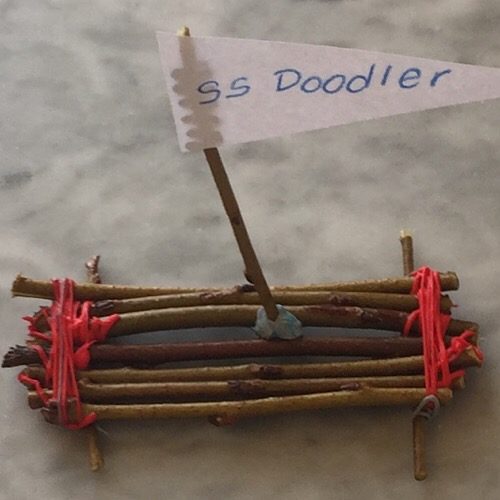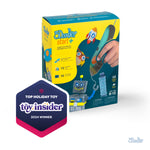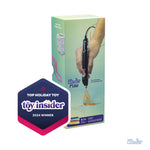STEM: Floating Doodles (Buoyancy: Sink or Float)
In this lesson, students will work in pairs to explore the buoyancy of water with boats that they've designed and created using a 3Doodler and other materials. Students will test out their boats in the water to see which one can float the longest.

KnowledgeStudents havehad experience using the 3Doodler to draw lines, shapes and fill, in addition to welding various objects together.
tested a variety of materials to determine which ones sink or float in water.
had experience using the 3Doodler to draw lines, shapes and fill, in addition to welding various objects together.
tested a variety of materials to determine which ones sink or float in water.
ObjectivesStudents willunderstand the concepts of buoyancy and water displacement.
sketch a plan for a boat they will build together.
use a 3Doodler and craft elements to build a boat.
test their boats for buoyancy, i.e., which boat can stay afloat the longest and carry the most weight.
understand the concepts of buoyancy and water displacement.
sketch a plan for a boat they will build together.
use a 3Doodler and craft elements to build a boat.
test their boats for buoyancy, i.e., which boat can stay afloat the longest and carry the most weight.
MaterialsStudents will need3Doodler (1 per pair)
tub filled with water (1 per class)
design elements, e.g., tape, straws aluminum foil, popsicle sticks, paper cups, cork, plastic cups, twigs, leaves, buttons paper, fabric, etc.
pennies (2-3 per pair)
Sink or Float Poem (1 per pair)
pencil (1 per pair)
timer (for teacher)
3Doodler (1 per pair)
tub filled with water (1 per class)
design elements, e.g., tape, straws aluminum foil, popsicle sticks, paper cups, cork, plastic cups, twigs, leaves, buttons paper, fabric, etc.
pennies (2-3 per pair)
Sink or Float Poem (1 per pair)
pencil (1 per pair)
timer (for teacher)
Lesson PlanInstructions
Step 1 - PREPARATIONSet up a table that students can access with materials they can choose from to use to build their boats.
Print out Sink or Float Poems, one for each pair of students. This document contains the poem and a section for students' sketches.
Step 2Call the students together to have a group discussion.
Share the goal: Students will work in pairs to create a boat that will stay afloat the longest. They will integrate the 3Doodler in their design. Other than that, they may choose 1-2 additional materials from the table, e.g., straws, twigs, buttons, etc.
Step 3Project a tablet or computer screen on the board for students to view the Sink or Float Poem. Read the poem together.
Ask students: Why did the first and second boats fail?
Discuss how the sailor could have checked for holes. Display a doodled object with a tiny hole. Note that you can see the hole best held up to the light. Ask students to guess what the "winning boat" was made from.
Step 4Call students up to view the materials on the table. Select a 3Doodler and 1-2 materials. Model how to sketch a design for a boat below the Sink or Float Poem in the box incorporating these materials. Engage students to predict whether it will sink or float. What is their reasoning? Discuss balance, symmetry, absorption.
Step 5Important: There is more than one solution to this design challenge. The images shared in this lesson display just two.
*Note that when making a raft from twigs, each stick must be individually wrapped to the one before it with the 3Doodler. The same thing could be accomplished with popsicle sticks. It is up to you how much guidance you offer students.
Step 6Pass out the Sink or Float Poem sheets for students to sketch their designs in the box supplied. Read the poem once again for motivation. Call pairs up two at a time to choose 1-2 design elements. Remind students that they will also be using a 3Doodler.
Step 7Instruct partners to sketch a design for their boat. Check students' sketches before passing out the 3Doodlers. Circle to assist and assess as pairs work together to build their boats.
Set up a table that students can access with materials they can choose from to use to build their boats.
Print out Sink or Float Poems, one for each pair of students. This document contains the poem and a section for students' sketches.
Call the students together to have a group discussion.
Share the goal: Students will work in pairs to create a boat that will stay afloat the longest. They will integrate the 3Doodler in their design. Other than that, they may choose 1-2 additional materials from the table, e.g., straws, twigs, buttons, etc.
Project a tablet or computer screen on the board for students to view the Sink or Float Poem. Read the poem together.
Ask students: Why did the first and second boats fail?
Discuss how the sailor could have checked for holes. Display a doodled object with a tiny hole. Note that you can see the hole best held up to the light. Ask students to guess what the "winning boat" was made from.
Call students up to view the materials on the table. Select a 3Doodler and 1-2 materials. Model how to sketch a design for a boat below the Sink or Float Poem in the box incorporating these materials. Engage students to predict whether it will sink or float. What is their reasoning? Discuss balance, symmetry, absorption.
Important: There is more than one solution to this design challenge. The images shared in this lesson display just two.
*Note that when making a raft from twigs, each stick must be individually wrapped to the one before it with the 3Doodler. The same thing could be accomplished with popsicle sticks. It is up to you how much guidance you offer students.
Pass out the Sink or Float Poem sheets for students to sketch their designs in the box supplied. Read the poem once again for motivation. Call pairs up two at a time to choose 1-2 design elements. Remind students that they will also be using a 3Doodler.
Instruct partners to sketch a design for their boat. Check students' sketches before passing out the 3Doodlers. Circle to assist and assess as pairs work together to build their boats.
Wrap Up
Assessment
Possible Extensions
Resources
Vocabulary
analyze - examine methodically and in detail the constitution or structure of (something, especially information), typically for purposes of explanation and interpretation.
balance - an even distribution of weight enabling someone or something to remain upright and steady.
boat - a small vessel propelled on water by oars, sails, or an engine.
buoyancy - the ability or tendency to float in water or air or some other fluid.
collaboration - to work jointly with others or together especially in an intellectual endeavor.
conclusion - a judgment or decision reached by reasoning.
construction - the building of something, typically a large structure.
data - factual information (such as measurements or statistics) used as a basis for reasoning, discussion, or calculation.
design - to prepare the preliminary sketch or the plans (for a work to be executed), especially to plan the form and structure of an object, building, bridge, etc...
engineering - the art or science of making practical application of the knowledge of pure sciences, as physics or chemistry, as in the construction of engines, bridges, buildings, mines, ships, and chemical plants.
experiment - a scientific procedure undertaken to make a discovery, test a hypothesis, or demonstrate a known fact.
float - rest or move on or near the surface of a liquid without sinking.
force - strength or energy as an attribute of physical action or movement.
hypothesis - a supposition or proposed explanation made on the basis of limited evidence as a starting point for further investigation.
math - the science of numbers and their operations, interrelations, combinations, generalizations, and abstractions and of space configurations and their structure, measurement, transformations, and generalizations.
motion - the action or process of moving or being moved.
observation - an act or instance of noticing or perceiving.
problem-solving - the process or act of finding a solution to a problem.
science - a branch of knowledge or study dealing with a body of facts or truths systematically arranged and showing the operation of general laws.
STEM - science, technology, engineering, and mathematics, considered as a group of academic or career fields.
synthesize - combine (a number of things) into a coherent whole.
Educational Standards
Participate in collaborative conversations with diverse partners about grade level topics and texts with peers and adults in small and larger groups.
Students will discuss how to build a boat that floats with the whole group and with a partner during design and construction phases of this activity.
Build on others' talk in conversations by linking their comments to the remarks of others.
Students will build on the talk of others during the whole group discussion, and with their assigned partner throughout this project.
Ask questions, make observations, and gather information about a situation people want to change to define a simple problem that can be solved through the development of a new or improved object or tool.
Students will ask questions and explore the given materials to solve the problem of designing a boat that will float the longest.
Decompose (break down) a larger problem into smaller sub-problems with teacher guidance or independently.
Students will break down the process of designing a boat that will float the longest through asking questions, sketching a solution, and testing materials.
Use technology to seek feedback that informs and improves their practice and to demonstrate their learning in a variety of ways.
Students will use a 3Doodler as part of the construction of the boat.
Create original works or responsibly repurpose or remix digital resources into new creations.
Students will construct an original plan for a boat that incorporates a 3Doodler.
Use collaborative technologies to work with others, including peers, experts or community members, to examine issues and problems from multiple viewpoints.
Students will work with a partner and with peers throughout all phases of this activity.





